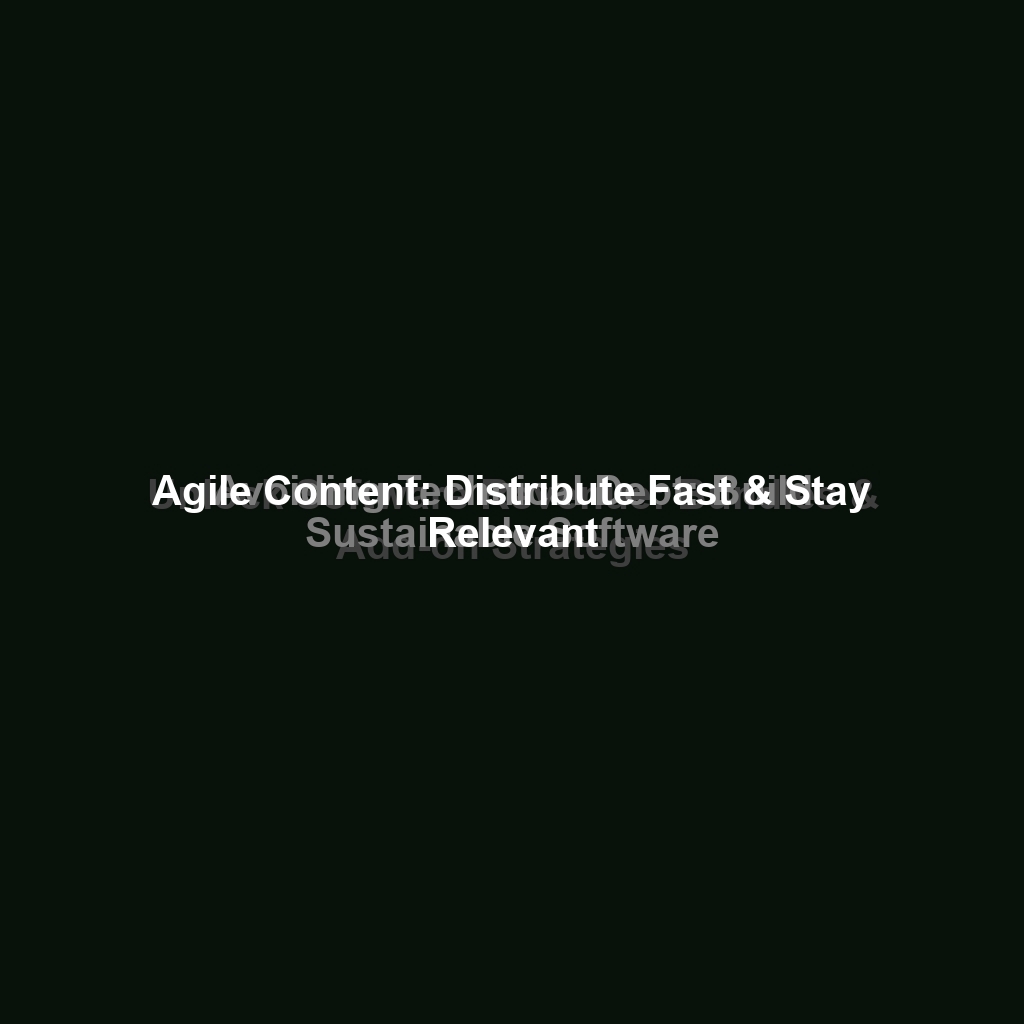Specialized software, by its very nature, addresses niche needs. While a laser focus can be a strength, it also presents a monetization challenge: how do you extract maximum value from a limited, albeit highly targeted, user base? The answer often lies in strategic bundling and add-on offerings. This article delves into the art of bundling specialized software with complementary tools or services to increase average revenue per user (ARPU) and enhance customer value. We’ll explore how to identify synergistic products and services, price and package bundles effectively, and leverage add-ons and extensions for further customization and revenue generation.
Understanding the Power of Bundling
Bundling, in its simplest form, is offering two or more products or services together as a single package at a combined price. For specialized software, this approach can be particularly powerful for several reasons:
- Increased ARPU: Customers spend more upfront on a bundle than they might on individual products.
- Enhanced Value Proposition: Bundles offer a more complete solution, making your software more attractive.
- Reduced Customer Acquisition Cost (CAC): Selling a bundle can be more efficient than acquiring customers for each product separately.
- Improved Customer Retention: Customers invested in a broader suite of tools are less likely to churn.
However, not all bundles are created equal. A poorly conceived bundle can confuse customers, devalue your core product, and ultimately hurt sales. The key is to identify products and services that offer genuine synergy and address a cohesive set of customer needs. Let’s look at some real-world examples.
Identifying Synergistic Products and Services
The foundation of successful bundling lies in understanding your customers’ workflow and pain points. What tasks do they typically perform alongside using your core software? What other tools do they rely on? Where are the friction points in their existing processes?
Here are some common approaches to identifying synergistic opportunities:
- Workflow Analysis: Map out your ideal customer’s entire workflow, from initial need to final outcome. Identify areas where your software integrates with other tools or where supplementary services could streamline the process.
- Customer Surveys and Interviews: Directly ask your customers about the other tools they use and the challenges they face. This is invaluable for uncovering unmet needs and potential bundling opportunities.
- Support Ticket Analysis: Analyze your support tickets to identify recurring issues or questions related to integrations, missing features, or common user errors. These insights can point to areas where bundling could provide a better user experience.
Key Insight: Data-driven insights from customer interactions and usage patterns are crucial for identifying high-value bundling opportunities. Don’t rely solely on intuition.
Real-World Scenario: I once consulted with a company specializing in project management software for construction firms. They noticed, through support tickets and customer interviews, that many users were struggling with basic accounting tasks like invoicing and expense tracking. While their software excelled at scheduling and resource allocation, it lacked financial management features. We recommended bundling their core software with a simplified accounting module specifically tailored for construction projects. This bundle proved to be a significant success, attracting new customers who valued the integrated solution and increasing ARPU among existing users.
Types of Bundles
There are several common bundle types, each with its own advantages and disadvantages:
- Product Bundles: Combining different software products or features within your own suite. Example: Basic version of a software + advanced reporting module.
- Service Bundles: Combining your software with related services like training, consulting, or support. Example: Software license + onboarding assistance + dedicated account manager.
- Cross-Product Bundles: Partnering with other companies to offer a bundle of complementary products. Example: CAD software + a 3D rendering tool from a different vendor.
Choosing the right type of bundle depends on your specific product, target market, and business goals. Consider the following factors:
- Customer Needs: Which combination of products and services best addresses their core pain points?
- Integration Complexity: How difficult is it to integrate the different components of the bundle?
- Pricing Strategy: How will you price the bundle to maximize profitability while remaining competitive?
Pricing and Packaging Your Bundles
Effective pricing and packaging are critical for the success of any bundle. Here’s a framework to guide your decision-making:
Cost-Plus Pricing
Calculate the cost of each component in the bundle and add a desired profit margin. This ensures profitability but may not be optimal for maximizing revenue. It’s a solid starting point, though.
Value-Based Pricing
Determine the perceived value of the bundle to the customer and price it accordingly. This can be significantly higher than cost-plus pricing, but requires a deep understanding of customer needs and willingness to pay.
Competitive Pricing
Analyze the pricing of similar bundles offered by competitors and adjust your pricing accordingly. This is important for staying competitive, but don’t solely rely on competitor pricing without considering your unique value proposition.
Key Insight: Value-based pricing, while more challenging to implement, often yields the highest returns for bundles, as it reflects the true worth of the integrated solution to the customer.
Bundle Packaging Strategies
The way you present your bundle can also impact its perceived value. Consider these strategies:
- Highlight the Savings: Clearly communicate the price difference between buying the bundle and purchasing the individual components separately.
- Emphasize the Convenience: Showcase the ease and efficiency of using a single, integrated solution.
- Create Tiered Bundles: Offer different bundle options with varying levels of features and services to cater to different customer segments. For example, a “Basic” bundle, a “Professional” bundle, and an “Enterprise” bundle.
Practical Application: A SaaS company offering CRM software packaged its product with email marketing automation tools. They presented three tiers: “Starter” (CRM only), “Growth” (CRM + Basic Email Marketing), and “Pro” (CRM + Advanced Email Marketing + Dedicated Support). The “Growth” package, priced attractively, became the most popular option, significantly boosting their ARPU. They actively marketed the saving by showing what it would cost to acquire similar email marketing services separately.
Leveraging Add-ons and Extensions
Add-ons and extensions offer another powerful way to monetize specialized software. Unlike bundles, which are pre-defined packages, add-ons and extensions allow customers to customize their software experience and pay for only the features they need.
Benefits of Add-ons and Extensions
- Increased Revenue Streams: Generate additional income from users who need more functionality.
- Enhanced Customization: Cater to the specific needs of different customer segments.
- Improved User Engagement: Encourage users to explore and utilize more features of your software.
Types of Add-ons and Extensions
- Feature Enhancements: Add new capabilities to your core software, such as advanced reporting, data analysis tools, or integration with other platforms.
- Customization Options: Allow users to personalize the look and feel of their software, create custom workflows, or add custom fields.
- Integration Modules: Connect your software with other popular tools and services, such as CRM systems, marketing automation platforms, or accounting software.
Pricing Add-ons and Extensions
The pricing of add-ons and extensions should reflect their value and the demand for them. Consider these pricing models:
- One-Time Purchase: Charge a fixed fee for each add-on or extension.
- Subscription-Based Pricing: Charge a recurring fee for access to specific add-ons or extensions. This can be monthly or annually.
- Usage-Based Pricing: Charge based on the amount of usage of an add-on or extension. For example, charging per API call or per data record processed.
Key Insight: Data analytics play a pivotal role in pricing add-ons. Observe usage patterns, conversion rates, and customer feedback to dynamically adjust pricing for optimal revenue generation.
Personal Anecdote: I worked with a company that developed specialized image editing software. They initially offered a single version of their software with all features included. However, they realized that many users only needed a subset of the features. We recommended offering add-ons for advanced features like noise reduction, color correction, and batch processing. They priced these add-ons at a reasonable price point, and many users opted to purchase them, significantly increasing their overall revenue. Furthermore, by offering specific modules they could better target their marketing and create specific learning materials for the advanced features.
Promoting Bundles and Add-ons
Simply offering bundles and add-ons is not enough. You need to actively promote them to your target audience.
- Highlight Bundles and Add-ons on Your Website: Create dedicated pages showcasing the benefits of each offering.
- Incorporate Bundles and Add-ons into Your Sales Process: Train your sales team to identify opportunities to upsell bundles and add-ons to existing customers.
- Use Email Marketing to Promote Bundles and Add-ons: Send targeted emails to users who might benefit from specific offerings.
- Offer Limited-Time Promotions: Create a sense of urgency by offering discounts or special deals on bundles and add-ons.
Common Pitfalls to Avoid
While bundling and add-ons can be powerful monetization strategies, there are some common pitfalls to avoid:
- Over-Bundling: Including too many products or services in a bundle can confuse customers and devalue your core product.
- Lack of Integration: Bundling products or services that don’t integrate well can lead to a poor user experience.
- Complex Pricing: Confusing pricing structures can deter customers from purchasing bundles or add-ons.
- Ignoring Customer Feedback: Failing to listen to customer feedback can lead to the development of unpopular bundles and add-ons.
Conclusion: Mastering the Art of Bundling and Add-ons
Bundling and add-ons are powerful tools for maximizing revenue potential with specialized software. By understanding your customers’ needs, identifying synergistic products and services, and implementing effective pricing and packaging strategies, you can significantly increase your ARPU, enhance customer value, and drive long-term business growth. Remember that continuous monitoring, testing and adjustment are key to long-term success. Don’t be afraid to iterate on your bundles and add-ons based on customer feedback and market trends. By following the strategies outlined in this article, you can master the art of bundling and add-ons and unlock the full revenue potential of your specialized software.
Ready to explore how bundling and add-ons can transform your specialized software monetization strategy? Let’s connect and discuss tailored solutions for your specific business challenges.
This article was optimized and published by Content Hurricane.


